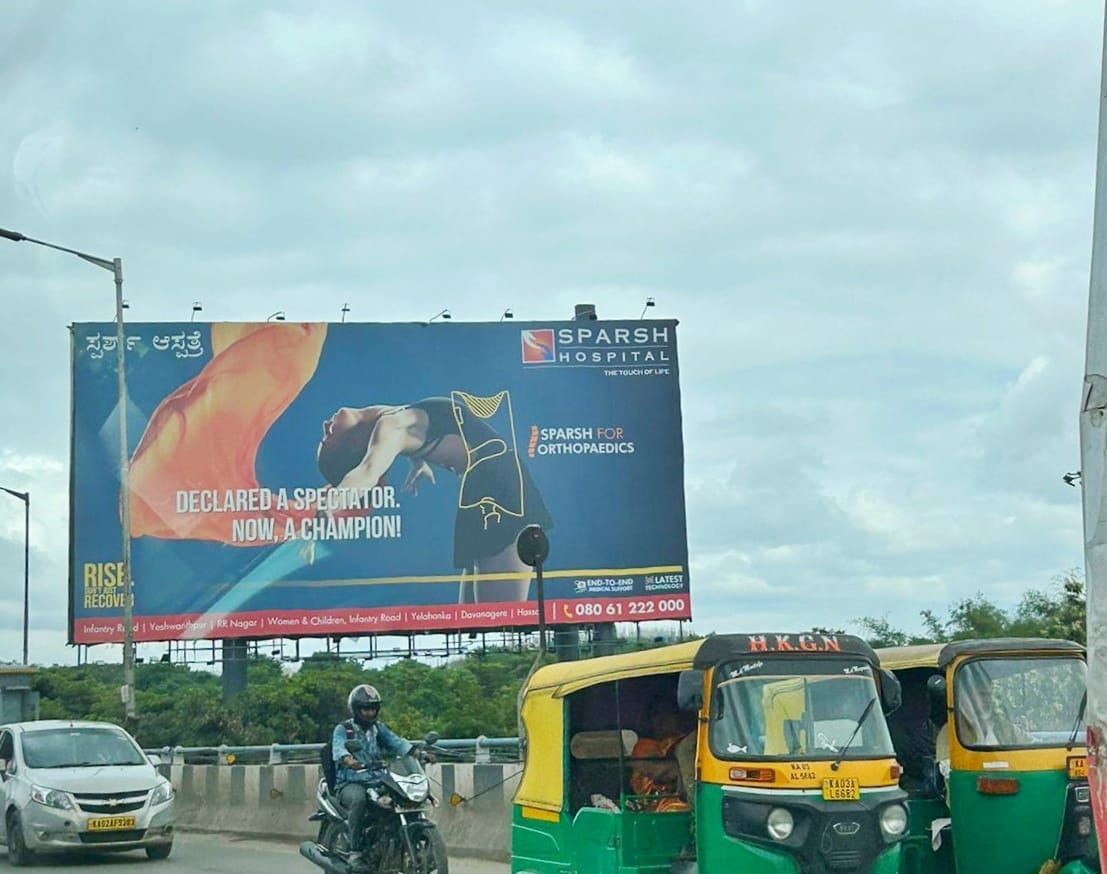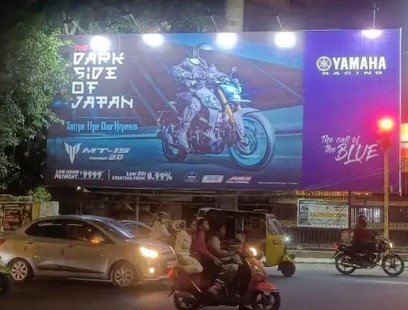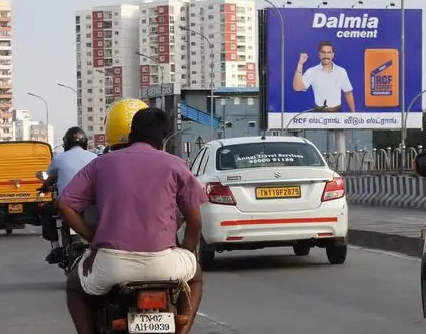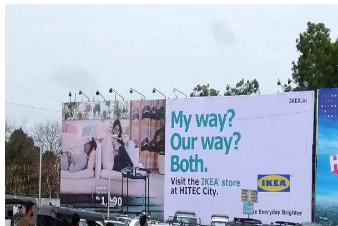What makes OOH the superstar in South?
Robust infrastructure & growth of transit media flavoured with local cultures and quirks is driving OOH in the southern metros and beyond, share industry players
Robust infrastructure & growth of transit media flavoured with local cultures and quirks is driving OOH in the southern metros and beyond, share industry players

Out-of-home (OOH) activations in South India are deeply rooted in culture. Metros in each state have unique cultural and linguistic features that brands can leverage to create campaigns that resonate with local consumers. Brands can drive significantly higher engagement by tapping into the region’s distinct traditions, festivals, and local pride.
Last year, OOH media in the country grew by 13% to Rs 41.6 billion. FICCI-EY estimates suggest that the revenue will touch Rs 46.6 billion by 2024 and Rs 54.3 billion by 2026. While traditional OOH brought in 62% of revenue for OOH last year, transit media stood strong at 38%.
The report lists emerging entertainment, sports and cultural venues in tier 2 and 3 cities as factors that will boost the addressable OOH inventory and revenues. This trend can be seen in the OOH progression in South India . While Bengaluru, Chennai, Hyderabad and Kochi continue to enjoy a large share of the OOH activations pie in South India, Mysore, Coimbatore and Vizag are emerging as secondary markets with increasing OOH activity, said Jayesh Yagnik, Chief Executive Officer, MOMS Outdoor Media Solutions.
“Tirupati, Trivandrum, Madurai, and Vijayawada have a high potential. Robust infrastructure like metro systems, airport expansions, and better highways could elevate their OOH significance,” he added. Much of OOH growth in the cities of South India can be attributed to the rise of transit media as airports and metro premises as prime spots for advertising.
Other key spots include roads with heavy traffic and city centres with high footfall during weekends and festivals. These factors make OOH a key component of the region’s landscape.
According to experts, understanding and embracing hyperlocal linguistic and cultural diversity in the region is critical for success. Embracing Tamil, Telugu, Kannada and Malayalam in creative communication gives brands the boost they need to create an emotional bond with their audiences. The recipe for success in the region requires coupling linguistic nuances with deep insights into the regional culture — daily lives, key moments, ways of celebration and leisure, and priorities of the audiences.
Speaking about the unique aspects of OOH activations in South India, Yagnik said, “Regional celebrities and language dominate messaging, especially in Tamil, Telugu, and Kannada markets.”
“Brands often localize campaigns with Tamil, Telugu, Kannada, and Malayalam scripts to connect better with the audience. Ads often feature visuals and narratives rooted in local culture, traditions, and festivals. Themes around sustainability, family values, and innovation resonate well here,” he added.
Let’s look at how each South metro city is scaling in the OOH domain.
Bangalore
Bangalore, the IT hub, has a consistent demand for premium OOH inventory due to a large urban population, tech-savvy audience and affluent consumers. The culture of quick commerce, affluence, ease of living and an affinity for leisure after work hours reflect prominently in the OOH activations here.
The city regularly sees high-impact activations, especially at hotspots like MG Road and Brigade Road, which see high footfalls of shoppers and leisure seekers. The area has several large-format billboards, which are almost always filled with advertisements for clothing and jewellery brands. Most of the brands featured in these OOH activations have a showroom presence in the market area, attracting impulse buyers to step in and shop.
Bangalore is also a hotspot for advertisers experimenting with creative and quirky communication. Last month, Sparsh Hospital, Bengaluru, launched an integrated campaign to promote its orthopaedics department. OOH elevated its visibility by several notches, inviting people to change how they look at patients with orthopaedic injuries. The campaign for the Bengaluru-based hospital chain went live all over the city with a strong OOH presence in key spots: Tumkur Road, Chikkabanavara, Cunningham Road, Dickenson Road, Mysore Road, Yelahanka and Brigade Road.
“We were told that after an orthopaedic injury, most patients are seen as ‘bechara’ by society, people around them and most healthcare brands. But patients don't see themselves this way. Even if they get dejected, or feel restricted or angry at times, it doesn't become who they are. They are far more than their injuries. They simply want to return to being and doing what makes them, them.” said Yousuf Rangoonwala, the founder of Kakkoii Entertainment, sharing the key insight behind the campaign.

To attract and engage consumers, the main MG Road is lit up with bright lights during festivals and other key shopping events. Recently, SNITCH, which opened its second store in Bangalore, utilised the OOH activation potential of the area for a high-visibility campaign. It helped the brand become the perfect backdrop for consumers clicking pictures and selfies with the lights. It also added to the much-loved ‘vibes’ for the ever-moving vehicular traffic in the area.
For OOH advertisers, Outer Ring Road is another key area in Bangalore. It’s popular for tech-centric advertising targeting IT professionals. The area is home to many tech parks, connects almost half the city and has heavy vehicular traffic all day long. Almost every category of brand can be spotted on this route, including consumer goods, gym memberships, fashion, quick commerce, real estate, manufacturing, automobiles and OTT platforms.
The Kempegowda International Airport is the crown jewel for advertisers in Bangalore, especially for premium digital displays. The airport undoubtedly gives brands access to premium audiences from across the globe. Earlier this year, Swiggy Instamart had converted the airport into an OOH activation. Several products with Swiggy Instamart branding were placed on the belt at the baggage claim, surprising passengers in line waiting for their luggage.
Chennai
Chennai’s mix of cultural and industrial audiences makes it a hotspot for FMCG, real estate and automobile OOH campaigns.
“Chennai has multiple OOH medium options such as hoardings, bus shelters, transit advertising, digital screens, malls, metro, LED police booths, metro pillars, pole kiosks and LED centre medians,” said G Vinoth Kumar, Sales & Operations Head of the Chennai-based Adinn Advertising Services Ltd.
He further spoke about a city’s iconic hoarding: “The Gemini Flyover in Chennai is a landmark structure that spans across the bustling Anna Salai (Mount Road). It’s one of the city’s first flyovers and a key artery that eases traffic in the central business district. This hoarding at Gemini isn’t vacant for more than a day. Most of the retail and corporate brands prefer this hoarding due to the traffic and nearby attractions.”
The automobile industry is a key advertiser in Chennai and Tamil Nadu. Kumar explained, “If you travel on any major road in any district, you will find a campaign by a bike brand mentioning attractive offers. Irrespective of whether it's the festive season or not, there will always be bike brands advertising with offers.”

He added, “Jewellery is also a key category. Be it local or global brands, jewellery advertisers occupy 40% of the OOH mediums in the city.”
Sharing insights into the OOH landscape in Chennai, Kumar said, “OOH ads in Chennai use bilingual or multilingual formats, combining Tamil and English to ensure a broader reach. For example, a local brand might use Tamil for its core message while employing English for a slogan or product name to maintain an aspirational or global appeal.” He added that language and culture are critical to the success of OOH advertising in Chennai and Tamil Nadu.
Recently, Dalmia Cement launched a campaign with Ranveer Singh as their brand ambassador. For the OOH campaign in Chennai and Tamil Nadu at large, the brand’s creative featured the actor and the copy was in Tamil. It elevated the potential of the campaign to drive resonance.

“Advertisers who succeed in tailoring their messaging to the linguistic and cultural sensitivities of the region are more likely to resonate with consumers, enhance brand recall and drive engagement here,” he added.
Yagnik added to the list of premium spots for OOH activations in Chennai. He said, “The Chennai Airport is a key site for premium brand visibility and the Pallikaranai Flyover attracts advertisers with its high traffic and large-scale OOH opportunities.”
Hyderabad
Hyderabad’s growth in IT and pharma has boosted OOH activations in the city, with HITEC City being a prime spot. Other key areas include the premium OOH location, Rajiv Gandhi Interactional Airport, and Tank Bund Road for its scenic yet high-traffic area for brand displays.

Ikea’s entry into the country and its first large format store in Hyderabad led to one of the biggest OOH campaigns in the city’s history. It included over 150 activations to announce Ikea’s arrival and to showcase the range of products available in the store. From experience zones at the airport to ads on cabs and bus shelters, every nook and corner of the city was covered in an attempt to increase curiosity and engage consumers.
Hyderabad is also home to the country’s first twin anamorphic cuboids. The technology allows brands to showcase and promote their products with a 360-degree distortion-free visual experience. Placed inside the mall in October this year, Nexus Hyderabad, the cuboids are being used as part of experiential marketing campaigns to create larger-than-life visuals.
Kochi
The demand for OOH activations in Kochi is primarily driven by the growth in tourism and retail. Key locations for OOH in the city include the Marine Drive for lifestyle and tourism ads, and NH66 and the Lulu Mall for being high-visibility zones for brands. A quick drive into the city would reveal a treasure trove of ads catering to aspirants hoping to study abroad.
Exterior wraps and ads inside coaches make Kochi Metro a prime transit advertising platform for brands to increase their visibility in the city. Last year, GM Modular leveraged these touchpoints to launch the GM Red Train in Kochi. Covering 24 stations on the network, the train helped the brand tap into the metro’s ridership of over 1.5 Lakhs per day.